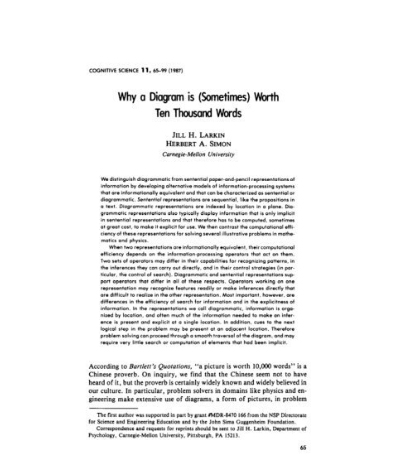A Diagram (Sometimes) Worth Ten Thousand Words
Here is an interesting phrase from Jill Larkin and Herbert Simon’s famous article. It is “Why A Diagram (Sometimes) Worth Ten Thousand Words”;

The phrase from the article
We consider external problem representations of two kinds. Both of which use a set of symbolic expressions to define the problem.
- In a sentinential representation, the expressions form a sequence corresponding, on a one-to-one basis, to the sentences in a natural-language description of the problem. Each expression is a direct translation into a simple formal language of the corresponding natural language sentence.
- In a diagrammatic representation, the expressions correspond, on a one-to-one basis, to the components of a diagram describing the problem. Each expression contains the information that is stored at one particular locus in the diagram, including information about relations with the adjacent loci.
The fundamental difference between our diagrammatic and sentinential representations is that the diagrammatic representation preserves explicitly the information about the topological and geometric relations among the components of the problem, while the sentinential representation does not. A sentinential representation may, of course, preserve other kinds of relations, for example, temporal or logical sequence. An outline may reflect hierarchical relations.
…
- Diagrams can group together all information that is used together, thus avoiding large amounts of search for the elements needed to make a problem-solving inference.
- Diagrams typically use location to group information about a single element, avoiding the need to match symbolic labels.
- Diagrams automatically support a large number of perceptual inferences, which are extremely easy for humans.
Larkin, J., Simon, H., (1987), “Why a Diagram is (Sometimes) Worth Ten Thousand Words”, Cognitive Science 11, pp. 65-99
My Thoughts on “A Diagram…”
While perusing this text, I found myself curious about the correlation between “formal languages,” “algorithmic architecture,” “scripting,” and “problem-solving” and why we teach them together. The introduction to these subjects occurred during my enrollment in the Shape Grammars graduate course. Over the past decade, a fascinating re-connection between algorithms and graphs has emerged, primarily facilitated by visual programming languages like Grasshopper. So, this has given rise to a novel comprehension of “formal languages” in design. This is surpassing the limitations of traditional sequential logic found in Shape Grammars. Nonetheless, ongoing research seeks to align these concepts and develop a design methodology centered around diagrammatic language and rule-based approaches. Regrettably, I haven’t had the opportunity to delve deeper into this subject yet. But it undoubtedly presents an enthralling and promising research area.








